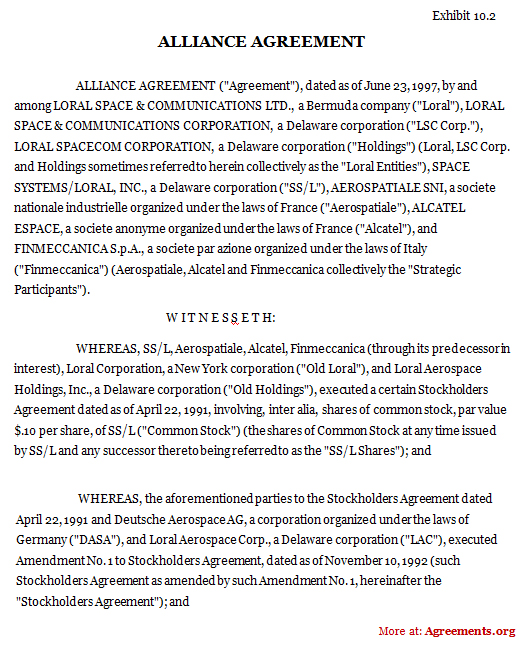What Is an Alliance Agreement?
An alliance agreement is an agreement made between two or more firms who agree to work together and share resources in a project. The resources include capital, marketing, or technology resources, etc. The businesses do not form any joint venture or a separate entity with one another while accessing the resources.
When Do You Need an Alliance Agreement?
- This agreement is also called as a strategic alliance agreement. A strategic alliance happens when two or more businesses work together and want to achieve long-term win-win benefits based on mutually anticipated outcomes.
- A strategic alliance is a legal agreement made between two or more corporations to share resources to achieve a competitive advantage.
- A strategic partnership is a relationship between two firms, which is formalized by business contracts.
Purpose of an Alliance Agreement
This type of agreement is made by allying with another firm. This is to use their resources and knowledge to run a business depending on a shared interest.
The strategic alliance allows a business to get a competitive advantage through sharing resources like products, distribution mediums, manufacturing capability, project finance, capital equipment, knowledge, expertise, or intellectual property with one another.
Key Terms of an Alliance Agreement
- An alliance agreement contains the scope and goal of the project, as well as the responsibilities of each company.
- It also contains the time limit of the agreement and how the two businesses would handle any incurred taxes, fees, and costs.
- This agreement allows a business towards accessing a partner’s resources, which comprises of technological and marketing resources, or intellectual property or any other resources.
Inclusions in an Alliance Agreement
Parties: This type of agreement made between two or more businesses.
Effective dates: This Agreement shall state the time when the agreement starts and when the agreement will expire, if applicable
How to Draft the Alliance Agreement?
The essential elements for drafting an agreement are;
- Sharing of Assets: In this agreement, two or more corporations must agree to share resources, which include labor, markets, technologies, capital, etc.
- Designation of Responsibilities: In an alliance agreement, it must specify each partner’s duties and obligations.
- Legal Structure: The partners in a strategic partnership have the option of forming a separate entity, in which each partner would share ownership.
The entity is considered as a joint-equity venture. In a joint-equity investment, each partner chooses their percentage of ownership in the venture.
The purpose of an alliance agreement is to specify the role of each party and their percentage of ownership in the venture. Also, each partner signs a memorandum of understanding.
- Complexities: A Strategic Partnership is complicated dowing to many complexities, for instance, negotiations between the parties or sharing of intellectual property, etc. For these reasons, it is essential to have a written agreement.
Benefits of an Alliance Agreement
The benefits of entering into a strategic alliance are;
- Knowledge and resource sharing between the entities like expertise, market knowledge, etc., which are considered to be more valuable than an individual effort
- Opportunities for growth by using the partner’s distribution network which help a firm to grow faster than it may on its own
- When corporations pool their resources and allow each other towards accessing manufacturing capabilities, economies of scale are achieved.
- Speed to market is a vital success factor in the competitive markets, and the right partner can assist in improving this.
- Corporations entering new markets reduce their exposure towards the market and political threat via forming strategic alliances with companies in their target markets
- Other benefits of entering into strategic partnerships consist of accessing new technologies, R&D resources as well as Intellectual Property rights, and decreasing administrative expenditures.
Types of an Alliance Agreement
There are three types of strategic alliances; they are Joint Venture, Equity Strategic Alliance, and Non-equity Strategic Alliance.
- Joint Venture: A joint venture is set up when the parent corporations establish a new child corporation.
For instance, Company X and Company Y (parent corporations) could form a joint venture by creating Company 2 (Child Corporation).
- Equity Strategic Alliance: A strategic equity alliance is formed when one corporation purchases a certain equity percentage of the other corporation.
For instance, if Company X purchases 40% of the equity in Company Y, a strategic equity alliance shall be made.
- Non-equity Strategic Alliance: A non-equity strategic partnership is formed when two or more corporations sign a contract to pool their resources as well as assets together.
[Also Read: Joint Venture Agreement]
What Happens When You Violation?
If there is a breach of responsibilities or any termination situations in an alliance agreement, and if the offense has caused any irreparable harm to the aggrieved party, then the party could seek equitable relief owing to any breach or threatened violation of this agreement. This includes injunctive relief against any infringement and specific performance of any provision, as well as any other remedy towards which the other party might be entitled.
Sample for Alliance Agreement
A sample of the agreement can be downloaded from below.

Download this USA Attorney made original Agreement for only $9.99
By clicking the button below, I agree with the Terms & Conditions.